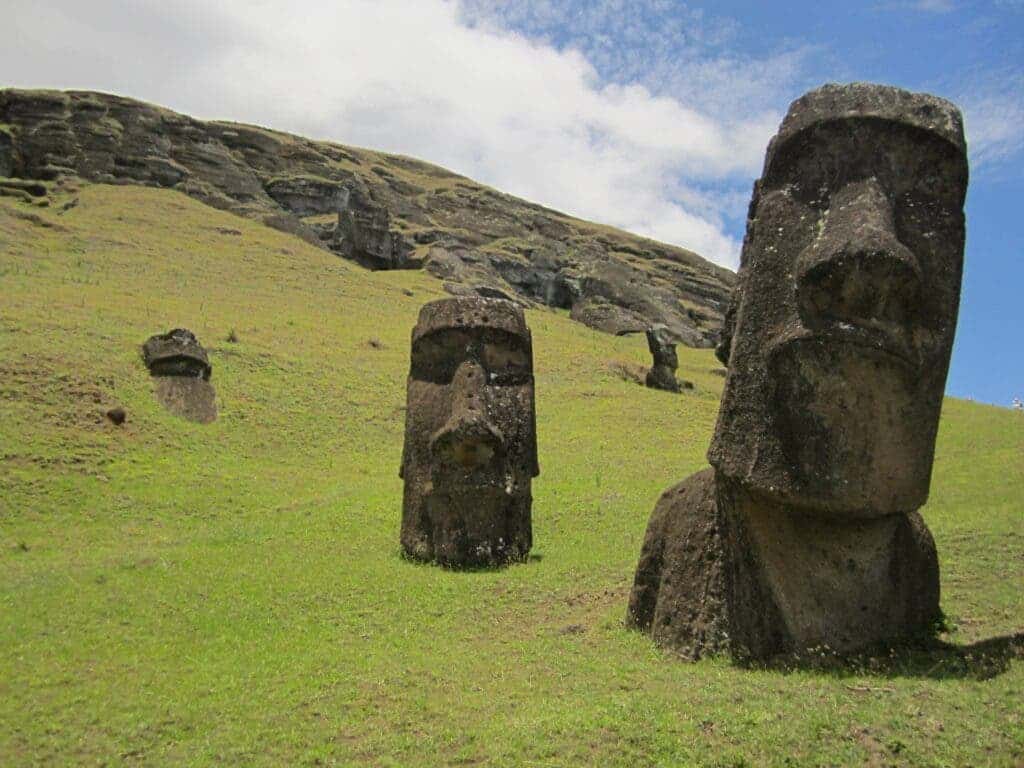
Located smack in the middle of the South Pacific Ocean, Easter Island is one of the most enigmatic places in the world. Even to this day, no one is sure how the first humans on the island managed to paddle at least 3,600 kilometers – the shortest distance from mainland South America. But the most mysterious feature of Easter Island is the nearly 1,000 monolithic statues that dot its surface.
We still don’t know how exactly the islanders moved the human-head-on-torso statues, known as “moai” in the native language. Why the early Easter islands undertook this colossal effort deep in their isolation is also a mystery.
Unfortunately, the natives did not keep a written record and the oral history is scant. But recent research is starting to fit at least some of the pieces into this puzzle, providing clues as to the purpose and significance of these stone giants that have stirred the public’s imagination for so long.
A most intriguing island and people
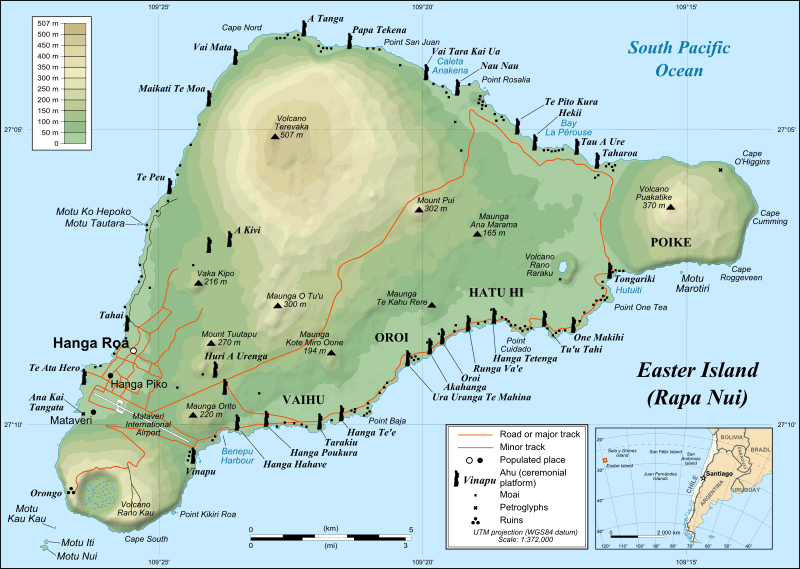
Easter Island, or Rapa Nui as it is known by the indigenous people, is truly a unique place. Although Pacific islands conjure the image of a tropical paradise, the triangular Easter Island is a very rugged landscape, lacking coral reefs and idyllic beaches. Geologically speaking, Easter Island is an amalgamation of three volcanoes that erupted sometime around 780,000 to 110,000 years ago, so it’s an extremely young island. It lies near the western end of a 2,500-kilometer-long chain of underwater volcanoes called the Easter Seamount Chain that resembles the classic Hawaiian hot spot track.
The original colonizers of the island are thought to have voyaged 2,000 kilometers from southeastern Polynesia in open canoes, or as far as 3,600 kilometers from mainland Chile. The most recent archeological evidence suggests colonization didn’t occur until about 1200 C.E. From that time until Dutch explorer Jacob Roggeveen first spied it on Easter Day 1722 – hence the island’s name – the people of Easter Island lived in absolute isolation from the outside world. No one from Easter Island sailed back to the mainland, nor did anyone from the mainland come to visit.
Once these people arrived at the island, that was it. They were stuck there and had to work with the limited resources they had at their disposal — and it wasn’t much. The volcanic material meant much of the soil was unusable for agriculture, but the natives did manage to grow yams, sweet potatoes, bottle gourds, sugar cane, taro, and bananas.
Intriguingly, although the island is tiny, which at 164 square kilometers is slightly smaller than Washington D.C., people were segregated into multiple clans that maintained their distinct cultures. Archeological evidence shows stylistically distinct artifacts in communities only 500 meters apart, while DNA and isotope analyses of the natives’ remains also showed that they didn’t stray too far from their homes, despite the small population size.
Speaking of which, researchers disagree about the size of the island’s population. Some estimate the population peaked at about 15,000 individuals, before it crashed to just a few thousand prior to European contact. Most estimates, however, hover at around 3,000 by 1350 C.E., and remained more or less stable until Roggeveen spotted the island, after which the population started decreasing as slavery and mass deportation followed shortly thereafter.
But what seems certain is that the Easter Island civilization was in decline well before Europeans first set foot on its shores. Easter Island used to be covered by palm trees for 30,000 years, as many as 16 million of them, some towering 30 meters high — but it is largely treeless today. Early settlers burned down woods to open spaces for farming and began to rapidly increase in population. Besides unsustainable deforestation, there is evidence that palm seed shells were gnawed on by rats, which would have badly impacted the trees’ ability to reproduce.
Once most of the trees were gone, the entire ecosystem rapidly deteriorated: the soil eroded, most birds vanished along with other plant life, there was no wood available to build canoes or dwellings, people started starving and the population crashed. When Captain James Cook arrived at the island in 1774, his crew counted roughly 700 islanders, living miserable lives, their once mighty canoes reduced to patched fragments of driftwood.
For this reason, the fate of Easter Island and the self-destructive behavior of its populace has often been called “ecocide”, a cautionary tale that serves as a reminder of what can happen when humans use their local resources unsustainably. However, more recent research suggests that deforestation was gradual rather than abrupt. And, in any event, archeological evidence shows that the Rapanui people were resilient even in the face of deforestation and remained healthy until European contact, which contradicts the popular view of a cultural collapse prior to 1722.
So, perhaps the Rapanui weren’t as foolish and reckless as some have suggested. After all, they not only managed to flourish for centuries on the most remote inhabited island in the world but built some of the most impressive monuments in history, the amazing moai (pronounced mo-eye)
What we know about the mysterious moai
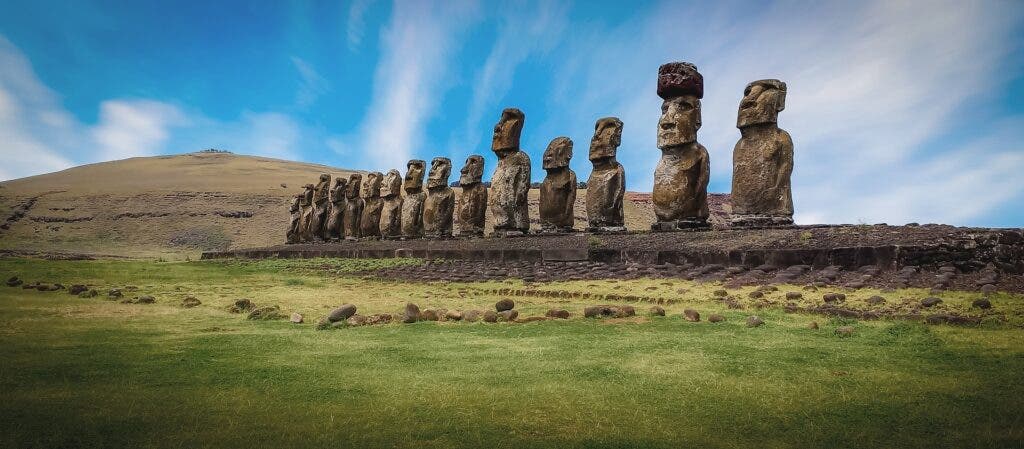
Archeologists have documented 887 of the massive statues, known as moai, but there may be as many as 1,000 of them on the island. These massive statues carved from volcanic rock usually weigh 80 tons and can reach 10 meters (32.8 ft) in height, though the average is around half that. The largest moai, dubbed “El Gigante”, weighs around 150 tons and towers at an impressive 20 meters (65.6 ft), while the smallest only measures 1.13 meters (3.7 ft). Each moai, carved in the form of an oversized male head on a torso, sits on a stone platform called ahu.
“We could hardly conceive how these islanders, wholly unacquainted with any mechanical power, could raise such stupendous figures,” the British mariner Captain James Cook wrote in 1774.
Archaeologists have documented 887 of the massive statues, known as moai, but there may be up as many as 1,000 of them on the island. These massive statues carved in volcanic rock usually weigh 80 tons and can reach 10 meters in height, though the average is around half that. The largest moai, dubbed “El Gigante”, weighs around 150 tons and towers at an impressive 20 meters, while the smallest only measures 1.13 meters. Each moai, carved in the form of an oversized male head with bust, sits on a stone platform called ahu.
More than 95% of the moai were carved in a quarry at the volcano Rano Raraku. This quarry is rich in tuff, compressed volcanic ash that is easy to carve with limited tools. The natives had no metal at all and only used stone tools called toki.
From the quarry, the heavy statues were transported to the coast, often kilometers away. They likely employed wooden logs which they rolled to move the massive monoliths or used wooden sleds pulled by ropes. However they managed to transport the statues, they did so very gently, without breaking the nose, lips, and other features. Accidents did sometimes happen though, since there are a few statues with broken heads and statues lying at the bottom of slopes.
Eyeholes would not be carved into the statues until they reached their destination. In the Rapanui civilization’s later years, a pukao of red scoria stone from the Pruna Pau quarry would sometimes be placed on the head of the statue, a sign of mana (mental power). The final touch would be marked with eyes of coral, thereby completing the moai, turning it into an ‘ariŋa ora or living face.
However, half of all identified moai, nearly 400 statues, were found still idling at the Rano Raraku quarry. Only a third of the statues reached their final resting place while around 10% were found lying ‘in transit’ outside of Rano Raraku. It’s unclear why so many moai never left their quarry after the craftsmen went to such lengths to carve them, but the great challenges when attempting to move such large blocks of stone didn’t make it easy.
Most of the transported moai are believed to have been carved, moved, and erected between 1400 and 1600 BCE. By the time Cook arrived at the island, the natives seem to have stopped carving such statues — or at least not nearly at the rate they used to — and were neglecting those still standing.
What were the moai for?
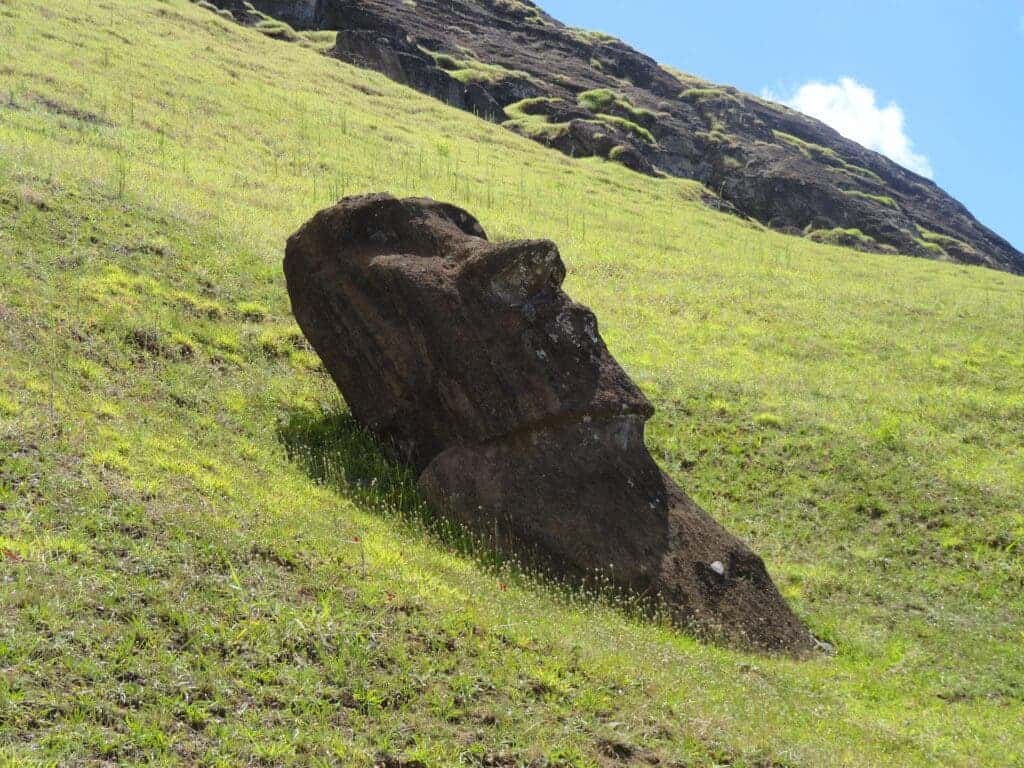
Many of the transported moai are found on Easter Islands’ southeast coast, positioned with their backs to the sea. The consensus among archaeologists is that they represent the spirits of the ancestors, chiefs, and other high-ranking males who made important contributions to Rapanui culture. However, the statues don’t capture the defining features of individuals, as you’d see in Roman or Greek sculptures of, say, Caesar or Alexander the Great. Instead, they’re all more or less standardized in design, representing a generic male head with exaggerated features.
Carl Lipo, an anthropologist at Binghamton University in central New York, doesn’t buy into the idea that moai represent their ancestors. There are no ahu and statues found on the top of hills, the obvious place where you’d expect to find monuments meant to send a symbolic message. The moai are instead placed right next to where the natives lived and worked, which suggests they may be landmarks positioned near a valuable resource.
Lipo and colleagues mapped the location of the moai alongside the location of various important resources, such as farmlands, freshwater, and good fishing spots. The statistical analysis suggests the moai sites were most associated with sources of potable water.
“Every single time we found a big source of freshwater, there would be a statue and an ahu. And we saw this over and over and over again. And places where we didn’t find freshwater, we didn’t find statues and ahu,” Lipo told Scientific American, adding that the statues weren’t exactly markers that communicate “this is where you can find drinking water”. That would have been highly impractical considering the Herculean task of carving and moving the statues. Instead, the statues were placed where they are since that’s where people could find the resources they needed to survive.
Since there were many culturally distinct tribes on the small island and there is a great deal of variation in terms of size for the statues, the moai could also serve to signal status to neighboring communities. Large statues are costly, meaning the biggest moai could be regarded as proof that a particular group of tribesmen is clever and hard-working.
Another line of thought suggests the statues are sacred sites of worship. When Roggeveen arrived on the island in 1722, he described in his ship log how he witnessed natives praying to the statues.
“The people had, to judge by appearances, no weapons; although, as I remarked, they relied in case of need on their gods or idols which stand erected all along the sea shore in great numbers, before which they fall down and invoke them. These idols were all hewn out of stone, and in the form of a man, with long ears, adorned on the head with a crown, yet all made with skill: whereat we wondered not a little. A clear space was reserved around these objects of worship by laying stones to a distance of twenty or thirty paces. I took some of the people to be priests, because they paid more reverence to the gods than did the rest; and showed themselves much more devout in their ministrations. One could also distinguish these from the other people quite well, not only by their wearing great white plugs in their ear lobes, but in having the head wholly shaven and hairless.”
Finally, the giant stone sculptures may have served an important role in farming — not for astronomy purposes as seen with other megalithic sites like Stonehenge but in the very literal sense. The soil on Easter Island is highly prone to erosion, especially in the absence of the once plentiful woods. But when Jo Anne Van Tilburg, an archeologist and head of the Easter Island Statue Project, sampled the soil around quarries, she found it was unexpectedly fertile, high in calcium and phosphorus.
“Our analysis showed that in addition to serving as a quarry and a place for carving statues, Rano Raraku also was the site of a productive agricultural area,” Tilburg said in a statement.
“Coupled with a fresh-water source in the quarry, it appears the practice of quarrying itself helped boost soil fertility and food production in the immediate surroundings,” said Dr. Sarah Sherwood, a geoarchaeologist and soils specialist at the University of the South in Sewanee and a member of the Easter Island Statue Project.
In related research, anthropologist Mara Mulrooney of the Bernice Pauahi Bishop Museum in Honolulu analyzed various archeological sites on the island and found the Rapanui people cultivated gardens of yams, sweet potatoes, taro and other crops in enclosures with stones and boulders strategically placed on the soil. The rocks not only protect the plants from the wind and deterred weed growth but also boosted soil nutrients thanks to the weathering of minerals.
When Tilburg and Sherwood excavated two of 21 partially buried statues on the slopes of Rano Raraku, they revealed each statue was etched with crescent shapes and other figures on their back. A carved human head found resting against the base of one of the statues suggests that these moai may have served a ceremonial purpose of some kind, perhaps related to plant growth.
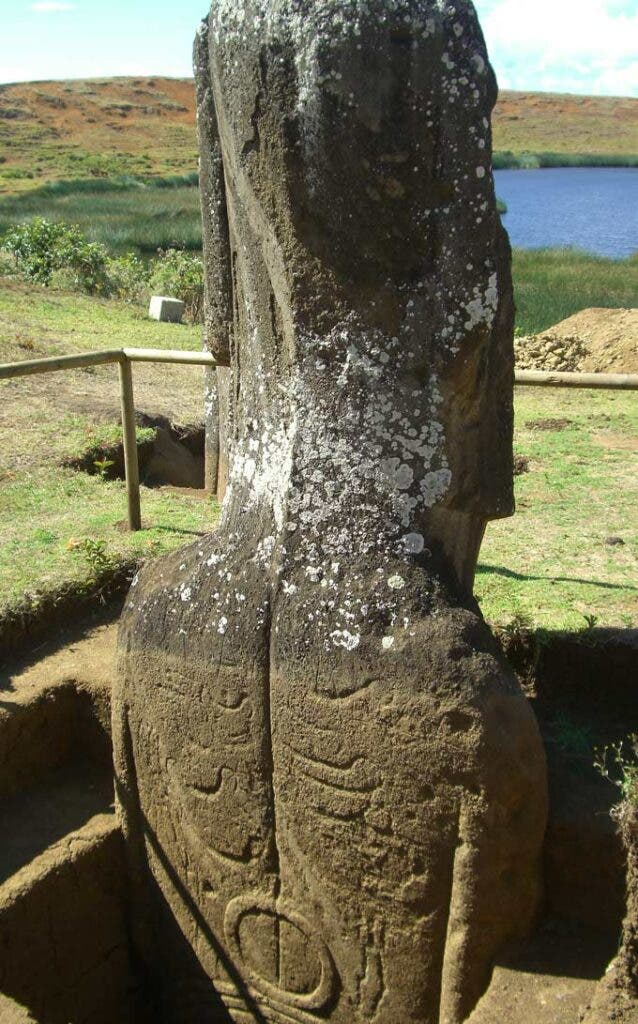
If quarry sites were the main farming plots, this would explain why so many statues haven’t been moved from their origin. Perhaps the islanders were not aware that the volcanic statues were making the soil fertile thanks to the minerals they contain, and instead attributed their plant growth to some divine intervention. As such, the statues may serve a double role as a ritual object and fertilizer.
The culture of Easter Island and why the heads are there is something we may never fully understand, but with each archeological trip, we are getting closer to uncovering the secrets of the Rapanui.


